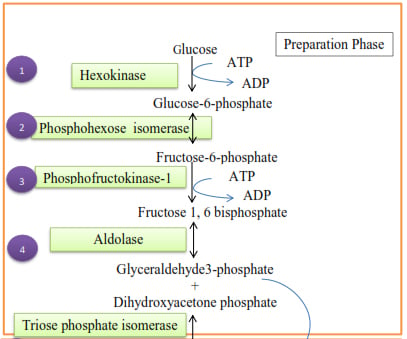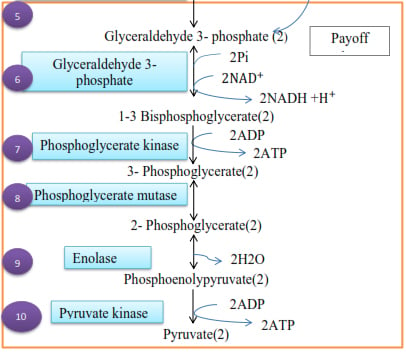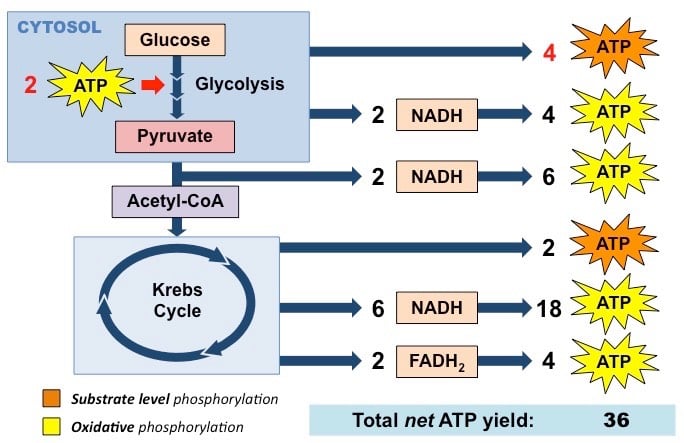Process That Allows Glycolysis to Continue to Make Atp Without Oxygen
- Fermentation and respiration are two major strategies for energy conservation in chemoorganotrophs.
- The glycolytic pathway is a major metabolic pathway for microbial fermentation which involves the catabolism of glucose into pyruvate.
- It is also called the Embden–Meyerhof–Parnas pathway for its major discoverers.
- Regardless of whether glucose is fermented or respired, it travels through this pathway thus it is referred to as the universal pathway of glucose catabolism.

Image Source: Quizlet Inc.
Location
Glycolysis takes place in the cytoplasm of cells in most body tissues.
Steps Involved in Glycolysis
- In glycolysis, a molecule of glucose is degraded in a series of enzyme catalyzed reactions to yield two molecules of the carbon compound – pyruvate.
- The fermentation of glucose through the glycolytic pathway can be divided into two stages, each requiring several independent enzymatic reactions.
- Phase I comprises of "preparatory" reactions : These are not redox reactions and do notrelease energy but instead form a key intermediate of the pathway.
- In Stage II, redox reactions occur, energy is conserved, and two molecules of pyruvate are formed.
Phase I: Energy investment phase (Preparatory phase)
- First five reactions of the pathway.
- Converts one glucose molecule to two glyceraldehyde-3- phosphate.
- Consumes two ATP.
- Includes rate-limiting step of the conversion of fructose-6-phosphate to fructose-1,6-bisphosphonate as catalyzed by phosphofructokinase.

Involved reactions
- Glucose is phosphorylated with the use of ATP by hexokinase, yielding glucose 6-phosphate.
- Glucose 6-phosphate is then isomerized to fructose 6-phosphate by phosphoglucose isomerase.
- Second phosphorylation leads to the production of fructose1,6-bisphosphate by phosphofructokinase 1 (PFK-1), which is the rate-limiting enzyme of glycolysis. The reaction uses 1 ATP.
- The enzyme aldolase then splits fructose 1,6-bisphosphate into two 3-carbon molecules, glyceraldehyde 3-phosphate and its isomer, dihydroxyacetone phosphate, which is ultimately converted into glyceraldehyde 3-phosphate.
Phase II: Energy production phase (Pay-off phase)
- Converts two G3P to two pyruvate.
- Produces four ATP and two NADH.

Involved reactions
- The first redox reaction is the oxidation of glyceraldehyde 3-phosphate to 1,3 bisphosphoglyceric acid by glyceraldehyde 3-phosphate dehydrogenase using NAD + as a cofactor.
- 1, 3-bisphosphoglyceric acid is converted to 3-phosphoglyceric acid by phosphoglycerate kinase. This reaction generates 2 ATP per glucose molecule.
- Reversible conversion of 3-phosphoglyceric acid to 2-phosphoglyceric acid by phosphoglycerate mutase.
- Reversible conversion of 2-phosphoglycerate to phosphoenolpyruvate (PEP) by enolase.
- Regulated, irreversible reaction involving the conversion of PEP to pyruvate by pyruvate kinase. There is a net gain of 2 ATP per glucose molecule in this reaction.
ATP generation
- During Stages I and II of glycolysis, two ATP molecules are consumed and four ATP molecules are synthesized.
- Thus, the net energy yield in glycolysis is two molecules of ATP per molecule of glucose fermented.

- However, maximal ATP yield from oxidation of glucose is 36 to 38 ATP.
- The maximum yield of ATP per glucose molecule depends on coupling of glycolysis with the citric acid cycle by means of pyruvate dehydrogenase.
Significance of Glycolysis Pathway
- The glycolytic pathway is employed by all tissues for the breakdown of glucose to provide energy in the form of ATP.
- Important pathway for the production of energy especially under anaerobic conditions.
- It is crucial for generation of energy in cells without mitochondria.
- It forms products that are intermediates for other metabolic pathways.
- Glycolysis interfaces with glycogen metabolism, the pentose phosphate pathway, the formation of amino sugars, triglyceride synthesis (by means of glycerol 3-phosphate), the production of lactate (a dead-end reaction), and transamination with alanine.
Associated Diseases:
Deficiency in any of the glycolytic enzymes leads to hemolytic anemia because RBCs depend on glycolysis for energy production and will lyse if their energy demands are not met as a result of faulty glycolysis.
References
- Lehninger, A. L., Nelson, D. L., & Cox, M. M. (2000). Lehninger principles of biochemistry. New York: Worth Publishers.
- John W. Pelley, Edward F. Goljan (2011). Biochemistry. Third edition. Philadelphia: USA.
- Madigan, M. T., Martinko, J. M., Bender, K. S., Buckley, D. H., & Stahl, D. A. (2015). Brock biology of microorganisms (Fourteenth edition.). Boston: Pearson.
- Rodwell, V. W., Botham, K. M., Kennelly, P. J., Weil, P. A., & Bender, D. A. (2015). Harper's illustrated biochemistry (30th ed.). New York, N.Y.: McGraw-Hill Education LLC.
delacruztatem1960.blogspot.com
Source: https://microbenotes.com/glycolysis-steps-atp-generation-and-significance/
0 Response to "Process That Allows Glycolysis to Continue to Make Atp Without Oxygen"
Post a Comment